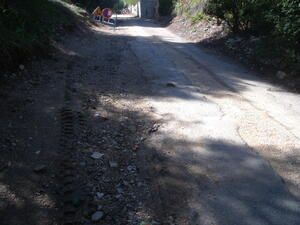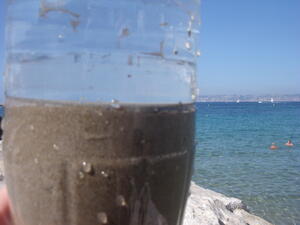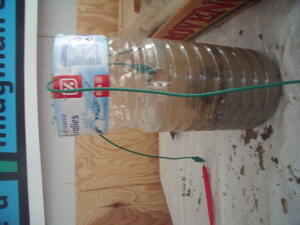Table of Contents
Experiment "Marseille3"
These experiments have been conducted during the open workshops of the What the Flok ? festival taking place in Marseille, from Septembre 29th to October 4th.
Crate Design #1
Design features
 Clay sampling spot - Niolon, France.
Clay sampling spot - Niolon, France.
- Substrate: topsoil gathered from La Friche's garden - two days before assembly - inoculated with 10 mL of clay gathered in Niolon (picture above) on the day of assembly.
- Volume: 80*30*2 cm3
- Container: crate, covered with a transparent garbage plastic bag.
- Proton Exchange Membrane: printer paper with low amount of ink.
- Surface: 80*30 cm2
- Water comes from La Friche's tap - maybe chlorinated.
- Anode: copper covered with carbon, extracted from a dead DELL PC battery found in the LFO storage space.
- Surface: 70*5 cm2
- Cathode: copper covered with less carbon, extracted from the same battery.
- Surface: 70*5 cm2
Performances
- Voltage: started at 30mV, went up avove 40, and dropped down to 0 in 2 hours.
- Current: started at 0.125 mA, and dropped down to 0 in 2 hours.
Max Power Measured: 3.75 microW
Crate Design #2
Design features
- Substrate: mud gathered from La Friche's garden on the day of assembly.
- Volume: 80*30*2 cm3
- Container: crate, covered with a transparent garbage plastic bag.
- Proton Exchange Membrane: three to four overlapping sheets of newspaper, covered in ink.
- Surface: 80*30 cm2
- Water: mainly rainwater from the mudsource, with some tap water (0.5L) to complement - maybe chlorinated.
- Anode: copper covered with carbon, extracted from a dead DELL PC battery found in the LFO storage space.
- Surface: 70*5 cm2
- Cathode: copper covered with less carbon, extracted from the same battery.
- Surface: 70*5 cm2
Performances
Performances on Day0:
- Voltage: around 5 mV.
- Current: around 0.1 mA.
Performances on Day1:
- Voltage: around 45 mV.
- Current: around 0.1 mA.
Performances on Day2:
- Voltage: around 130 mV peak.
- Current: around 0.5 mA peak.
- Strange measurement behavior:
- Voltage starts at 80 mV, and builds up to 130 mV in about 15 minutes.
- Current starts at 0.7mA and drops to 0.3mA in about 15 minutes too.
Performances on Day3:
- Voltage: around 250 mV, stable.
- Current: around 1.5 mA peak, decreasing slowly, stabilized around 0.60 mA.
Performances on Day4:
- Voltage: around 350mV, stable.
- Current: around 1 mA.
Peak Power Measured: 375 microW.
Max (stable) Power Measured: around 350 microW.
Pile Microbienne Marseillaise
Design features
 Marine sediments sampling spot - Marseille, France
Marine sediments sampling spot - Marseille, France
- Substrate: sea sediments gathered ten meters from the Catalan beach in Marseille on the day of assembly.
- Volume: 0.5L
- Container: 2L plastic bottle.
- Proton Exchange Membrane: a piece of cardboard.
- Surface: the bottle's section (diameter of 6-8 cm).
- Water: seewater.
- Anode: copper covered with carbon, extracted from a dead DELL PC battery found in the LFO storage space.
- Surface: 50*5 cm2
- Cathode: copper covered with less carbon, scrap from the supercapacitors experiment.
- Surface: 20*5 cm2
Performances
Performances on Day0:
- Voltage: about 13mV
- Current: about 0.1 mA
Performances on Day1:
- Voltage: about 110mV
- Current: starting at 7 mA ! And dropping slowly
Peak Power Measured: 770 microW
Observations
Even though the multimeter was connected the wrong way (+ on anode, - on cathode), we first had positive (and quite high) current and voltage value. Is this due to remanant charges from the PC battery ?
Conclusion
From both these expriments and those conducted in Bruxelles, we can conclude that the MFC behavior improves and stabilizes with time.
As the “pile micrboienne marseillaise” increases its performance way quicker than the “Crate Design #2” It seems that a better mcirobial & nutrient source induces quicker results.
Using newspaper or cardboard as a Proton Exchange Membrane seems fine.
New long-term experiments should be conducted to test other parameters, including more broadly available electrode materials.
